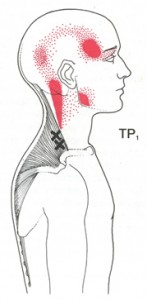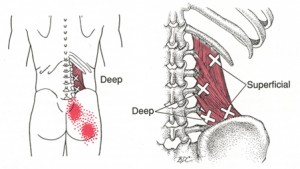Remarkably at birth our muscles harbour no adverse tension. At this point, muscles move without restriction through a full range of motion.
Over time, muscles are subjected to overuse and overload stresses, trauma and acute chilling (eg:by cold draughts). Due to these influences muscles develop TRIGGER POINTS or ‘knots’. These localised areas of tight muscle cause the tension and stiffness that is often felt in a body. Flexibility becomes limited and pain can develop.
Trigger points exist in either an ACTIVE or LATENT form. The more common LATENT TRIGGER POINTS cause stiffness, but not pain, as their pain activating threshold hasn’t been reached.
ACTIVE TRIGGER POINTS, however, do spontaneously refer pain, frequently distant to the location of that trigger point.
They commonly exists alongside nerve, joint and inflammatory issues.
They lead to increased decrepitude through life (charactised by more stiffness, less flexibility, poor posture, less function and more falls risk)
LATENT TRIGGER POINTS
- Exist in muscles but do not spontaneously cause pain
- More common than ACTIVE TRIGGER POINTS
- Unaware of their presence (unless felt as stiffness and lowered flexibility)
- Always tender when compressed in touch
- May become ACTIVE TRIGGER POINTS when they are stressed to a level that spontaneously refers pain
- Once ingrained in muscles can remain for months and years until identified and treated by a skilled physical therapist (eg myotherapist)
ACTIVE TRIGGER POINTS
- Are the ‘active’ part in muscles that cause muscle origin pain
- Cause pain commonly described as annoying, dull, tight, achey or occasionally sharp and grabbing
- Always tender when compressed in touch
- Less common than LATENT TRIGGER POINTS
- Frequently refer pain distant to their location
- The frequency and level of the pain they cause can vary greatly
- May revert back to a LATENT form when they are not stressed, only to be re-activated by further stress (can explain recurring pain syndrome)
- Once ingrained in muscles, can remain for months and years until identified and treated by a skilled physical therapist such as a myotherapist.
Myotherapy aims to de-activate ACTIVE TRIGGER POINTS to clear the body of muscular origin pain and to treat LATENT TRIGGER POINTS to restore the muscles full range of motion and function.
Regardless of your age, a myotherapist has the training and skills to identify trigger points and apply a range of techniques to provide effective treatment. This can be applied in a preventative, corrective or rehabilitative manner.
COMMON TRIGGER POINT PAIN PATTERNS
The following are two examples of the most commonly treated sources of Trigger Point pain.
The black X shows the location of the Trigger Point.The dark red areas show the most frequent pain referral zone. The dotted areas show the less common spillover pain referral zones.
1) THE UPPER TRAPEZIUS
The Upper Trapezius Trigger Point is one of the most common sources of one sided neck tension and pain or headache.
Common causes of Trigger Points developing in this muscle include:
- Sudden trauma. Eg whiplash from car accidents or falls.
- Habitual shoulder elevation due to stress and anxiety.
- Chronic overload from rounded shoulder and forward head posture.
- Lack of elbow support in your office chair.
- Spinal scoliosis leading to uneven shoulder heights.

Reference Travell and Simons: The Trigger Point Manual, Upper Extremities, Williams and Wilkins Baltimore 1983 (p184,Fig 6.1)
2) THE QUADRATUS LUMBORUM
The Quadratus Lumborum Trigger Point is a frequent source of low back pain. Pain from this muscle may also refer to the sacral, buttock and hip regions. A person suffering this pain may have great difficulty turning over in bed or even standing upright and walking. They also may be fearful of the pain accompaying coughing and sneezing.
Common causes of Trigger Points developing in this muscle include:
- Awkward lifting of heavy loads.
- Stooping to reach an object while the torso is twisted to one side
- Sustained repititious activity. Eg hours of gardening.
- Trauma. Eg car accidents or falls.
- Sudden awkward movements.

Reference Travell and Simons: The Trigger Point Manual, Upper Extremities,Williams and Wilkins Baltimore 1983 (p30,Fig 4.1,B and C)
